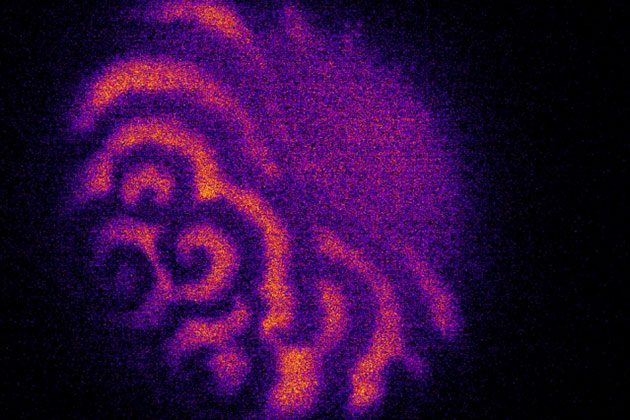Life begins with a universal whirl dance
Billions of activated proteins migrate in spiral patterns across the membrane of the egg cell, thus signalling to the egg cell the start of cell division and thus the emergence of a new living being. Copyright: Fakhri, Dunkel et al., "Nature Physics" 2020 / MIT
Cambridge (USA) - With images that are as spectacular as they are hypnotically beautiful, US researchers have succeeded in showing how life spreads in a newly fertilised egg cell when activated proteins spread in a spiral-shaped wave through the egg cell membrane, thereby giving the star signal for cell division.
As the team led by Professor Nikta Fakhri and Jörn Dunkel from the Massachusetts Institute of Technology (MIT) recently reported in the journal "Nature Physics" (
DOI: 10.1038/s41567-020-0841-9), the image shows a series of wave movements generated by billions of activated proteins in the cell membrane of the egg cell, which in this way give the egg cell the start signal for cell division, thus creating the cellular germ cell of an organism.
At the same time, the scientists describe that the same wave movements can also be observed in other systems, from oceans and atmospheric circulation to quantum fluids.
The researchers obtained the images with the help of starfish eggs, which they describe as model eggs of numerous other animal species. The scientists injected a specific hormone into these initially unfertilised eggs in order to simulate fertilisation and to observe and document the subsequent wave dance using fluorescent markers bound to a specific protein.
"Each wave appears in a kind of spiral pattern, moving in multiple forms simultaneously across the surface of the egg cell. Some of these spirals appear quite spontaneously and whirl away in different directions, while others collide directly with each other and immediately disappear again," the authors say.
The behaviour of these vortices can be compared to the behaviour of waves in other media and systems that are supposedly not connected to the egg cells. As examples, the researchers cite vortices in quantum fluids, which circulate in the Earth's atmosphere and oceans, and in patterns observed by electrical signals propagating through the heart and brain.
"So far, we know very little about the dynamics of these surface waves on eggs. After we were able to observe them for the first time, we started to analyze and model these waves and discovered that the same patterns occur in other systems," says Fakhri, adding: "It is a manifestation of an apparently universal wave pattern.
Earlier studies had already shown that fertilisation of an egg cell directly activates so-called Rho-GTP proteins, which are located - initially inactive - in the cytoplasm inside the egg cell. Once activated, billions of these proteins rise from the cytoplasm to the surface of the cell membrane, where they spread in the pattern now observed and described for the first time.
"Imagine a dirty aquarium in which a fish suddenly swims close to the glass wall and this is the only way to make it visible from the outside," explains Dunkel, and continues: "Something similar happens inside the cell and when these proteins are activated, they arrive at the cell membrane and begin to move across its surface. In this way, the cell begins to prepare itself for cell division around the nucleus.
"The egg itself is a large cell and all these proteins must work together to find the centre so that the cell knows where to divide and fold to form an organism," says Fakhri. "Without these proteins and their wavelike propagation, there would be no cell division."
On the basis of their recordings, the scientists were able to observe that the waves also propagate oscillating in small hurricane-like spirals. They also succeeded in tracing the origin of each of these waves back to the centre of each spiral - an effect that the researchers call a "topological defect". With the help of statistical analyses of how fast and often these spiral waves moved across the surface of the cell, in which configurations they occur, collide with each other and disappear again, the scientists discovered similarities in the behaviour of similar patterns in completely independent and much larger systems: "We are dealing here with a universal phenomenon that is reduced to the scale of a cell," says Dunkel.
For the researchers, the observation opens up completely new perspectives for the investigation of which one could use many techniques that are already being used by others to study similar vortex patterns in other systems, in order to learn more about biology. In further investigations, the researchers now want to transfer their observations to other systems: "Just as this wave pattern in an egg cell transmits special signals (in this case for cell division), data processing with a quantum computer, for example, is concerned with arranging atoms in a liquid in precise patterns in order to translate information and thus perform arithmetical operations. Perhaps we can learn from the spiral patterns of the cell and transfer this knowledge to quantum liquids in order to construct minicomputers from biological cells," concludes Fakhri. "Although we expect some differences, we want to try to use biological signal waves as another tool for quantum computers by further research".



